Le mois de Janvier est souvent un prétexte à de nouvelles résolutions, pour ceux qui le font encore. C’est vrai à titre individuel mais également au niveau collectif.
À l’occasion d’un passage dans une de mes équipes, on m’a demandé l’animation d’une rétrospective afin de leur redonner un second souffle pour les 6 prochains mois. En effet, le projet a de grands enjeux, l’équipe va se renforcer et il semblait important que chacun prenne conscience de son rôle à jouer.
Je leur ai proposé un TRIZ des liberating structures comme j’avais pu le faire précédemment ici. Mais à un contexte, son adaptation ! Voici ce qu’il s’est passé dans ce cas ! 😉
Pourquoi le choix de TRIZ ?

Mis à part mon goût tout particulier pour cette structure, le choix de TRIZ était d’autant plus adapté pour :
- Créer un cadre différent des rétrospectives usuelles orientées généralement sur ce que l’on peut faire de plus pour s’améliorer : ici l’objectif est avant tout de trouver ce que l’on peut arrêter de faire qui est contre-productif ce qui pour moi est bien plus dans la logique de simplicité et de frugalité que l’on prône en Agile
- Créer une ambiance conviviale, sérieuse mais sans se prendre au sérieux (ah tiens cela me rappelle quelque chose :-P) en commençant par détruire pour reconstruire
- Faire le point sur où l’on se situe personnellement et collectivement de manière factuelle au travers de la séquence d’auto-dénonciation
- Permettre à chacun de s’exprimer – qu’il/elle le veuille ou non – au moins une fois pendant la session : c’est l’une des grandes forces des Liberating Structures pour le coup
Structure d’animation

Dans mon idée, l’animation pouvait se composer de 3 parties :
|
PARTIE 1 |
une introduction faite par des membres de l’équipe sur le contexte et l’objet de ce moment à passer ensemble. L’objectif étant de donner une impulsion en interne plutôt que par mon biais. |
|
PARTIE 2 |
un travail collectif permettant de voir la situation actuelle ensemble et prendre des dispositions sur du court / moyen terme. |
|
PARTIE 3 |
une cristallisation des grands principes de fonctionnement de l’équipe à perpétuer dans le temps |
Comme à mon habitude, les informations minimales dont j’ai besoin sont :
- L’intention : Redonner une impulsion à l’équipe en la focalisant sur un objectif commun
- Le nombre de personnes : ici au nombre de 10
- La durée allouée : ici d’1h30 (de 9h30 à 11h)
Avec ces informations, je vais avoir la possibilité d’adapter la structure aux besoins des participants.
PARTIE 1 : Introduction
Pour cette introduction, j’ai demandé à ce que bien évidemment elle soit courte mais qu’elle mette bien en avant les enjeux, les constats et l’envie d’avancer ensemble.
Si l’on pouvait tenir dans 5 petites minutes, ce serait top ! 🙂
PARTIE 2 : Travail collectif
C’est ici que notre structure TRIZ va entrer en scène.
Si l’on part de l’animation théorique de la structure, on obtient :
- Définir le pire résultat imaginable vis-à-vis des objectifs et/ou de la stratégie de l’équipe (5 min)
- Lister ce qu’elle peut faire pour garantir d’atteindre ce résultat (10 min)
- Lister ce qu’elle fait aujourd’hui qui y ressemble de près ou de loin (10 min)
- Déterminer des actions ou des premières étapes leur permettant d’arrêter ces choses qu’elle sait être contre-productives (10 min)
On obtient alors ici un timing de 35 minutes.
En rajoutant un peu de marge avec les quelques temps de latence, j’ai compté entre 45 et 50 minutes pour l’ensemble du processus.
| Note : La raison est assez simple : chaque étape peut être effectuée à l’aide d’un 1-2-4-All (qui deviendra un 1-2-5-all dans mon cas) estimé à 10 minutes, ce qui de mon expérience a rarement pu être effectué convenablement dans ce laps de temps sans frustrer le groupe. |
PARTIE 3 : Cristallisation
L’objectif ici est de permettre à l’équipe de garder une impulsion sur du plus long terme que simplement sur une itération de quelques semaines.
Pour ce faire, nous allons réutiliser les résultats de la séquence précédentes pour formuler de grands principes de fonctionnement de l’équipe.
Je compte ici environ 20 minutes, sachant que les exercices de formulation sont de manière générale assez difficiles pour les équipes (de ce que j’ai pu voir).
| Note : L’idée initiale étant de les formuler sous la forme de commandement, pour le fun, mais aussi car la mémorisation en est souvent facilitée ! 🙂 |
On en arrive alors théoriquement à un contenu pour 1h30 en étant un petit peu serré. On verra bien comment les choses vont évoluer au fur et à mesure de l’atelier !
Maintenant que la conception a été décrite, voyons voir ce qu’il s’est passé sur le terrain !
Préparation
Comme on ne le répétera jamais assez, le succès d’un atelier repose essentiellement sur sa préparation.
Je me suis donc attelé à initier les posters qui vont servir de supports visuels tout au long de l’atelier.
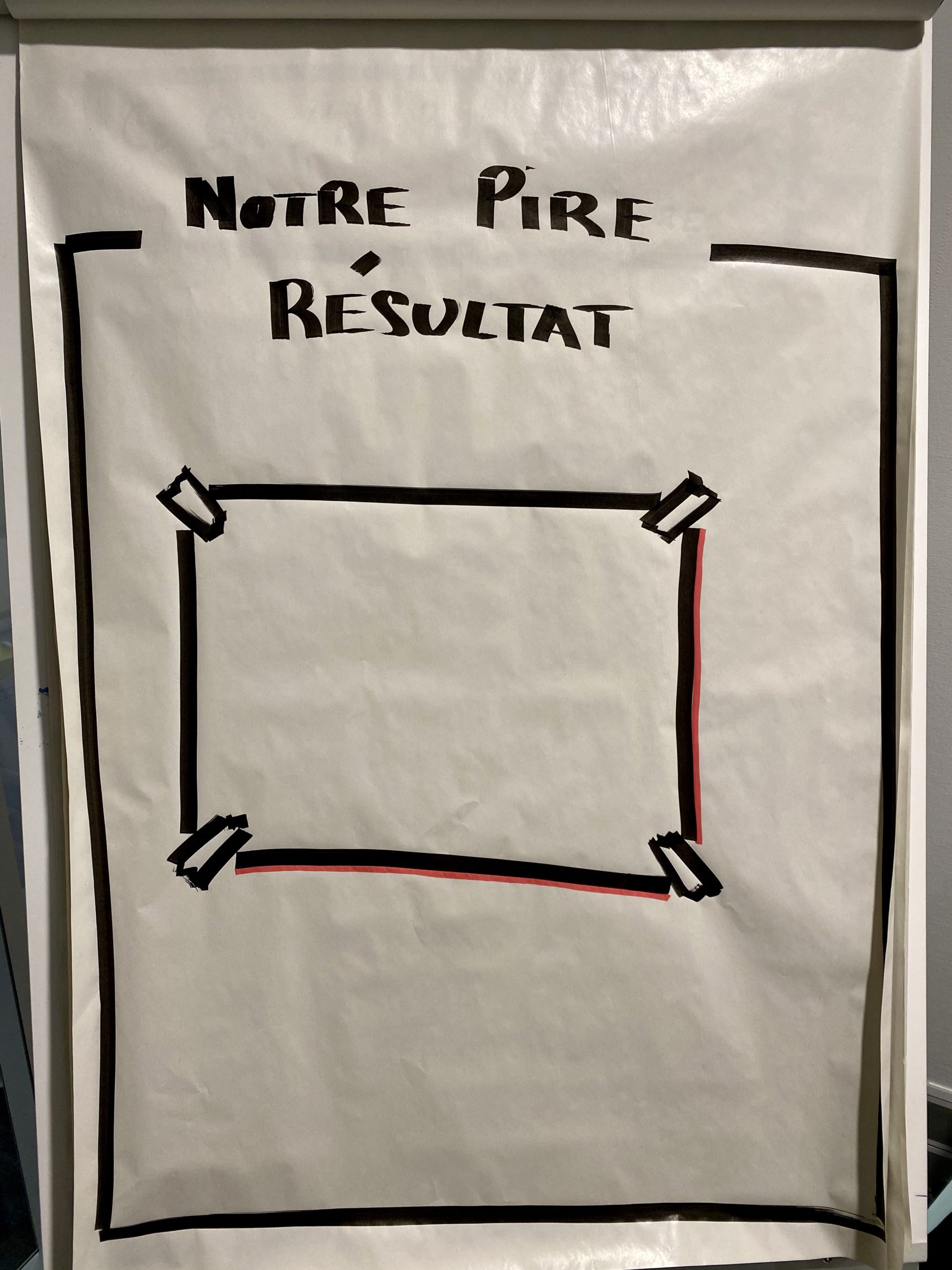
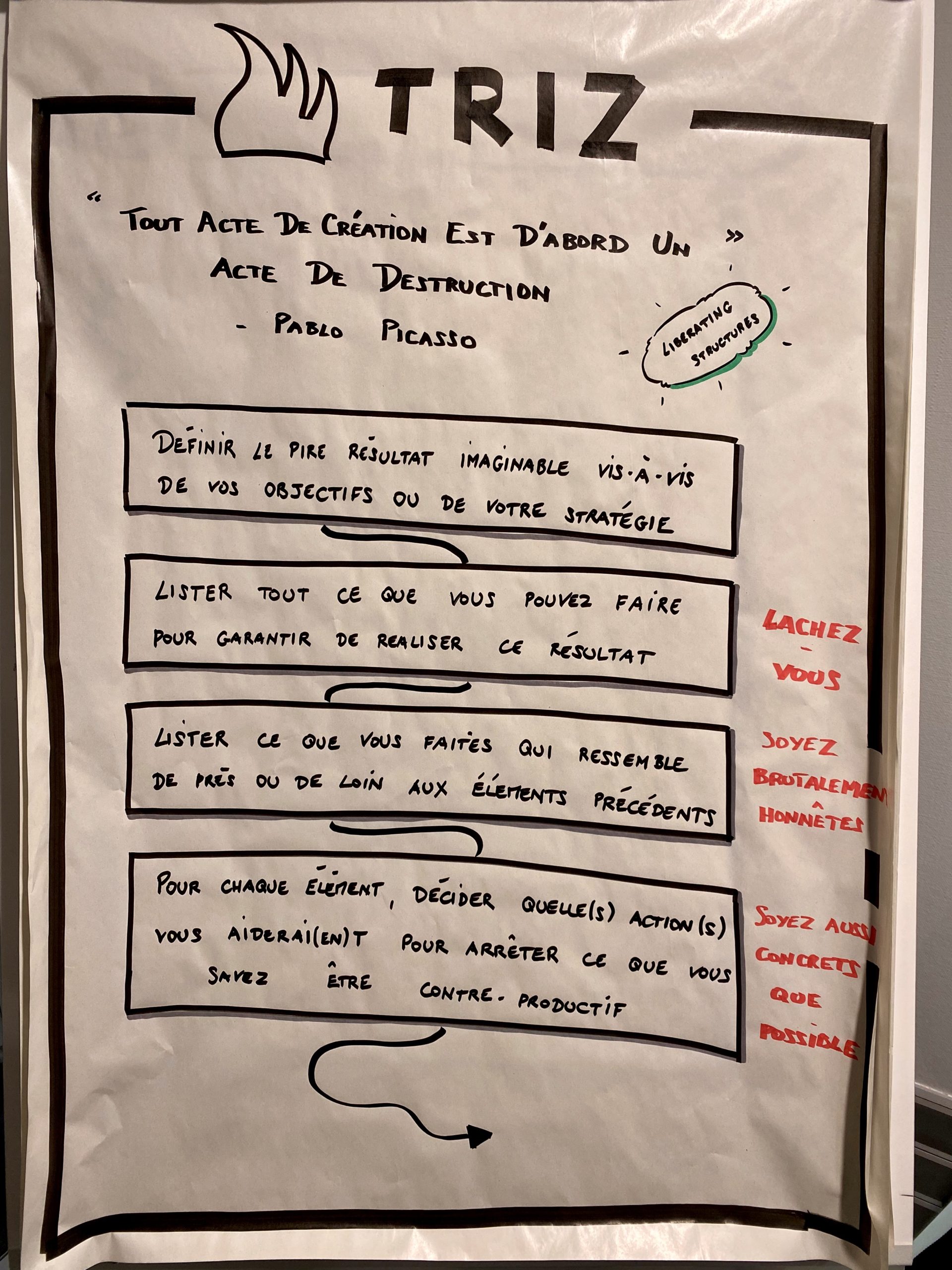
Déroulé
Comme tout atelier de fin de semaine qui se respecte, nous commençons avec un peu de retard suite à une arrivée de viennoiseries et une concentration des participants pas encore au rendez-vous ! 😛
Partie 1 : Introduction
Je démarre en demandant au groupe si chacun sait pourquoi nous sommes là ce jour, la réponse s’avère être plutôt mitigée pour une partie du groupe.
J’en profite alors pour donner la parole aux membres du groupe pour donner un peu de contexte puis nous nous lançons dans le coeur de l’atelier ! 😛
Partie 2 : Travail collectif
Dans un premier temps, je dévoile la description de la structure TRIZ aux participants. Je peux déjà voir sur les visages quelques sourires à la lecture des différentes étapes à venir, cela s’annonce donc plutôt intéressants !
Par précaution, je leur partage également le fonctionnement de la structure 1-2-5-Tous qu’ils auront à utiliser à de multiples reprises au travers de l’atelier.
Je leur indique que quoi qu’il arrive je les accompagnerais tout au long du processus pour les aider et leur rappeler les consignes.
Le pire résultat imaginable
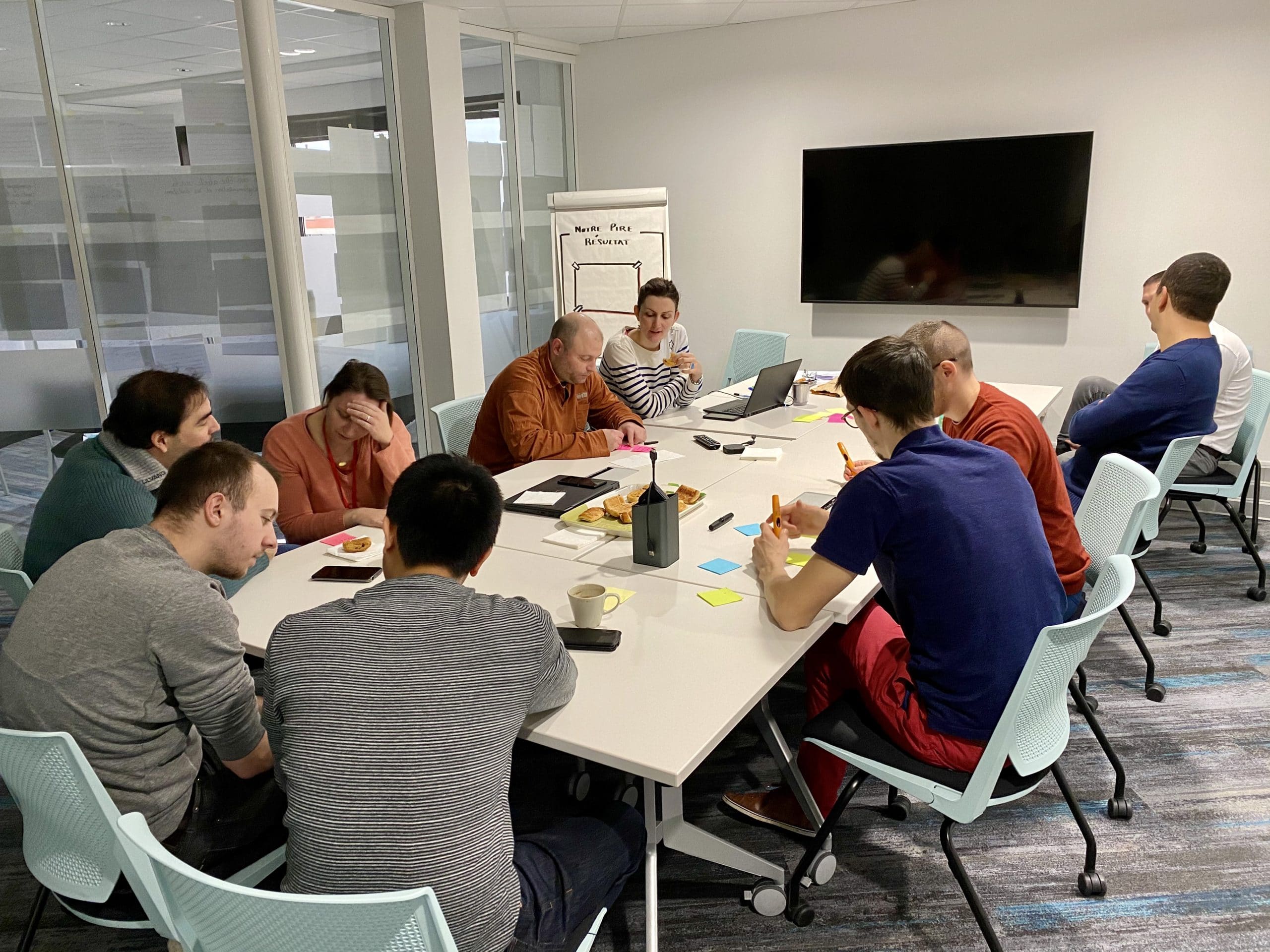
La question posée est la suivante :
Quel serait le pire résultat imaginable vis-à-vis de vos objectifs et/ou de la stratégie de votre équipe ?
Cette étape pourrait se faire en brainstorming mais pour habituer chacun à la structure du 1-2-5-Tous, je leur propose directement de l’utiliser. Je leur ai alors demandé à chaque tour de garder l’idée principale qui émergerait des échanges quitte à la reformuler pour qu’elle soit plus convenable.
Cela leur donne l’occasion de s’aligner sur ce que l’on pourrait entendre par « pire résultat » en rapport à ce qui a pu être partagé en début de session.
Le résultat est alors finalement plutôt simple mais focalise au moins tout le monde sur la même chose :
Rien ne marche, rien n’est livré au 10/06
Comment l’atteindre ?
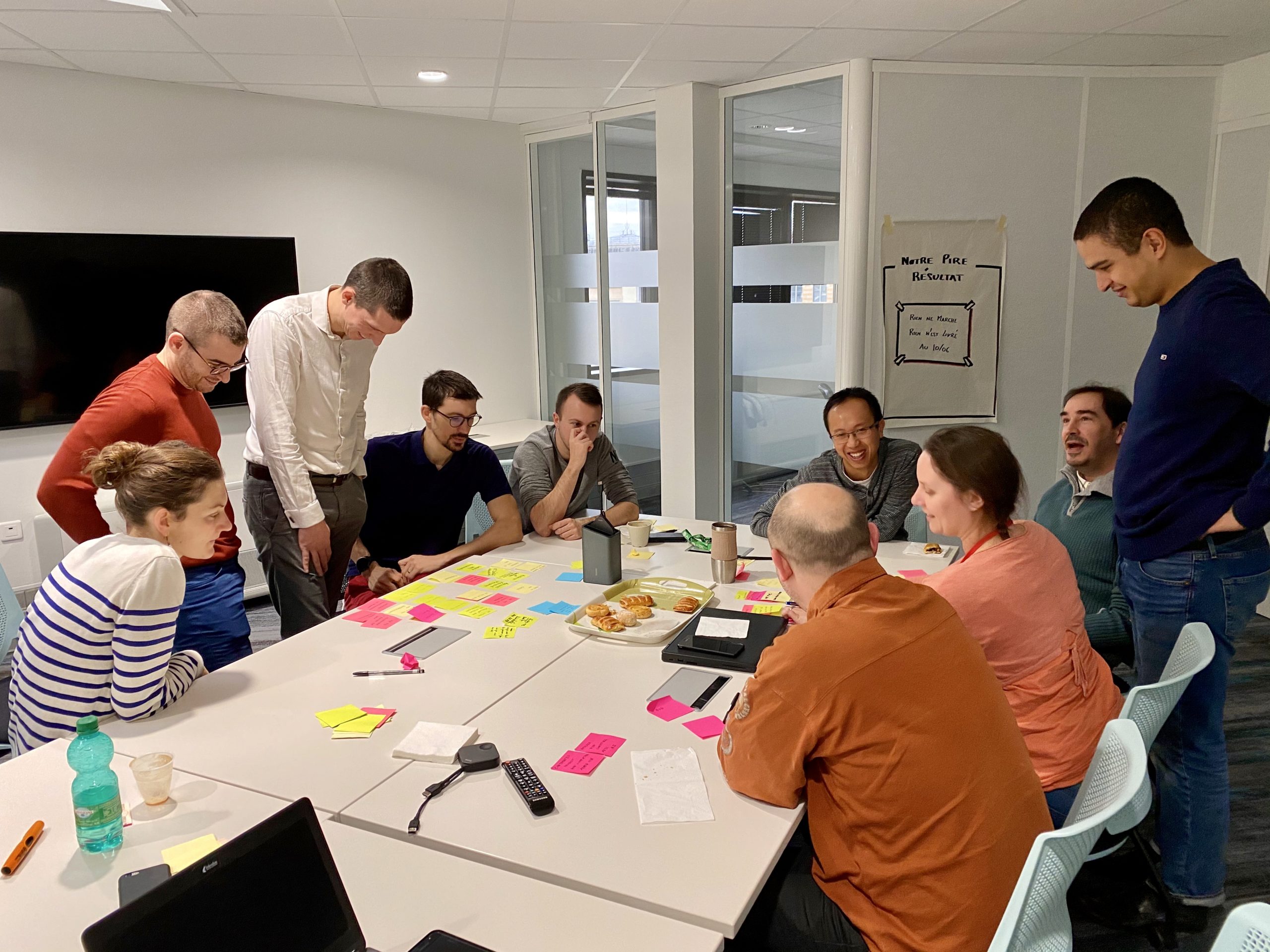
La question posée est la suivante :
Que pourriez-vous faire pour garantir de l’atteindre ?
Comme le suggère la page décrivant TRIZ, j’ai bien précisé aux participants de ne pas se donner de limites, de se lâcher ! Tout ce qui peut apparaître farfelu est donc bienvenu !
| Note : ce dernier détail est important afin de pouvoir libérer la puissance créative des participants. Cela crée en plus un climat généralement confortable pour la suite du processus. |
À la différence de l’étape précédente, je ne leur demande pas de ne garder qu’une idée à chaque étape du 1-2-5-tous mais d’éliminer les doublons et d’ajouter les nouvelles idées. En effet, mon intention est d’avoir du contenu pour préparer les étapes suivantes.
Nous débriefons ensuite en faisant passer un groupe qui va exposer ses idées, puis le second qui complètera avec son différentiel.
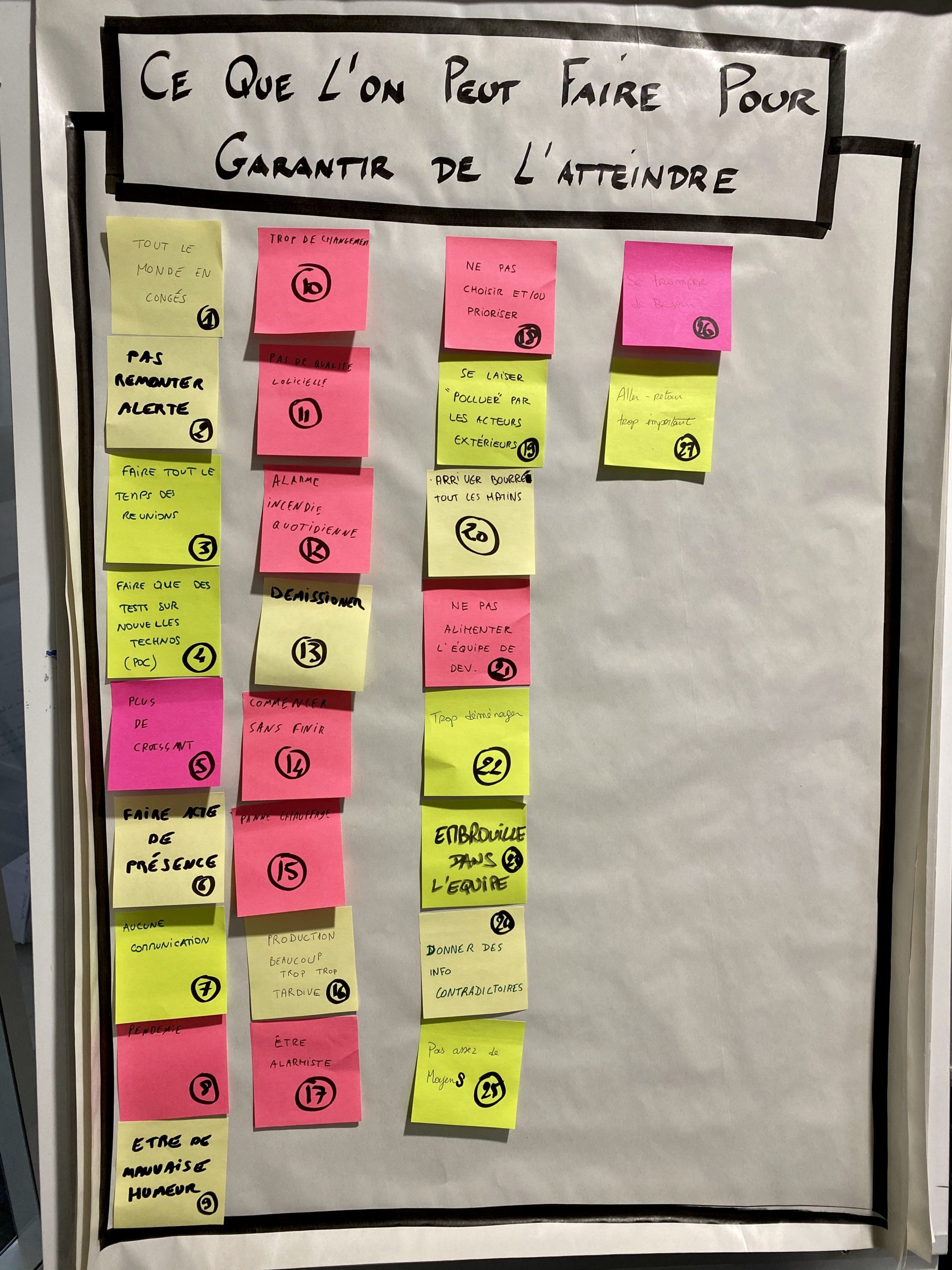
Nous avons numéroté chaque élément afin de pouvoir plus facilement s’y référer par la suite. Nous en arrivons tout de même à près d’une trentaine d’idées !
Comment fait-on aujourd’hui ?
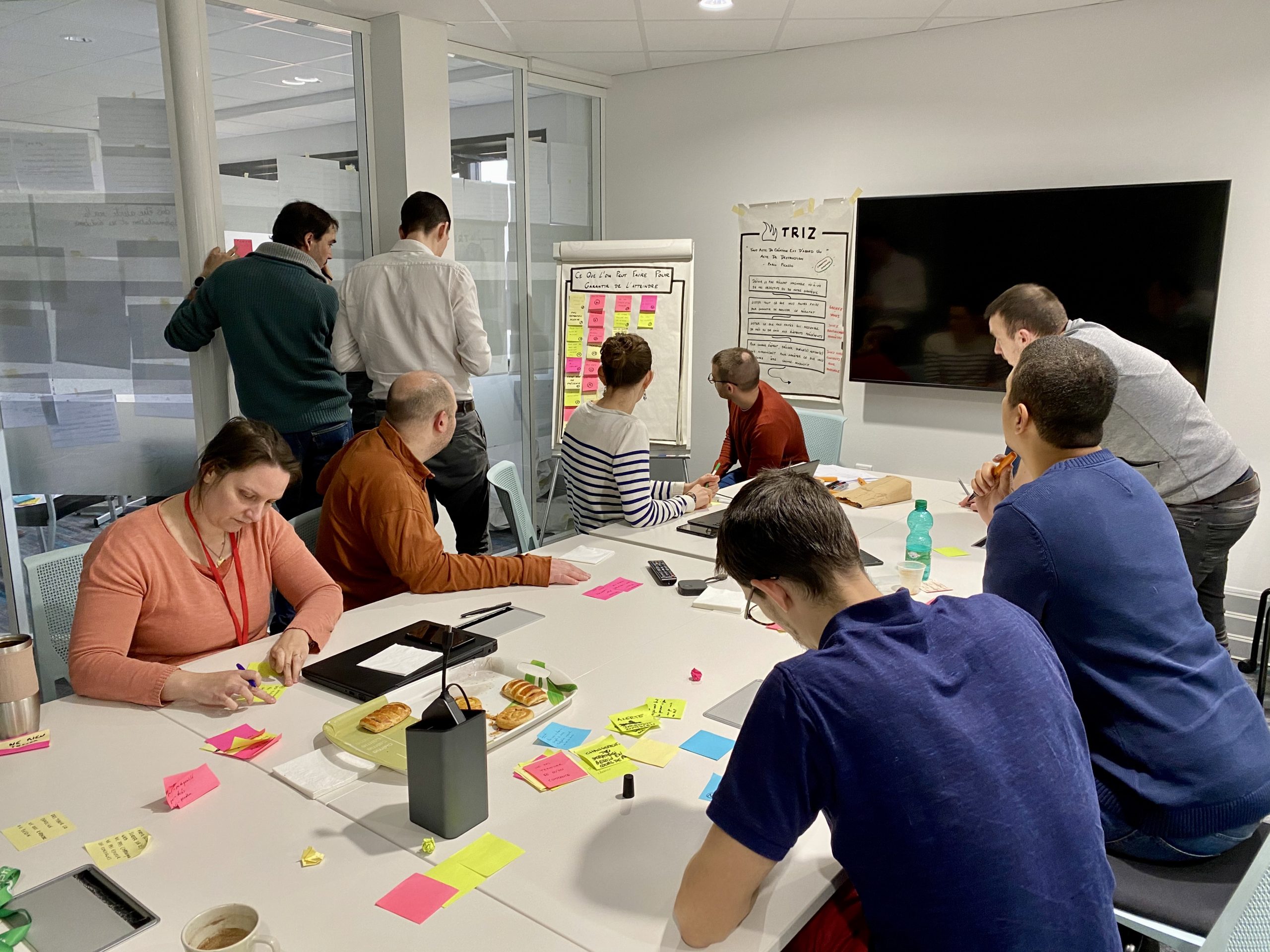
La question posée est la suivante :
Que faites-vous aujourd’hui qui ressemble de près ou de loin à des éléments de la liste précédente ?
Pour le coup, j’ai été très surpris de voir que chacun faisait vraiment l’effort de regarder chaque élément. Cela a bien évidemment entraîné le fait que le 1-2-5-Tous a pris bien plus de temps mais cela en valait la peine : chacun était en véritable recherche d’actes de sabotage !
Je suis toujours étonné de ce qu’il peut se passer à cette étape ou tout du moins dans ce genre d’exercice. De voir que les personnes réussissent à s’auto-dénoncer en public, avec un certain recul et sans jugements mutuels, cela fait plaisir à voir !
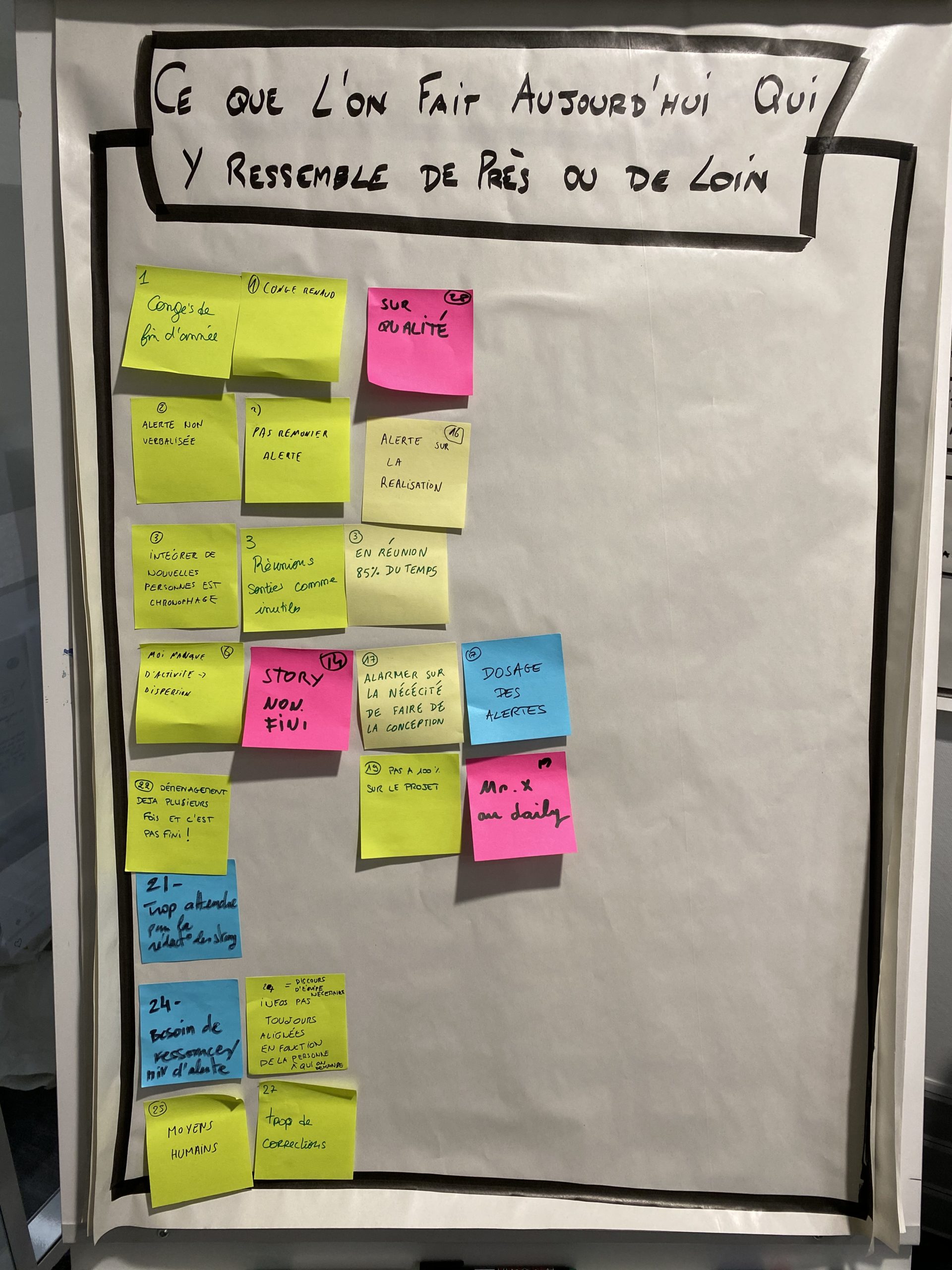
| Note : Une des difficultés de cette étape est bien de rester sur ce que l’on fait aujourd’hui qui ressemble aux éléments de la liste précédente sans aller dans la solution. |
Comment arrêter ?
La question posée est la suivante :
Quelles seraient les actions et ou premières étapes qui pourraient vous aider à arrêter ce que vous savez être contre-productif ?
Même expérience que pour l’étape précédente, le 1-2-5-tous prend du temps mais les échanges qui sont générés sont vraiment intéressants. Je crée alors l’espace pour que ces discussions aient lieu même s’il faudra peut-être sacrifier la dernière partie pour rester dans le timing.
En effet, 2 personnes sont attendues dans une réunion à 11h donc je suis en proie à un dilemne :
- Soit je déborde pour dérouler jusqu’au bout ce que j’avais prévu
- Intérêts : les idées sont encore chaudes pour être cristallisées en groupe, c’est l’étape qui selon moi permet de donner une impulsion à plus long terme même si l’ensemble du groupe n’est pas présent
- Inconvénients : moi qui suis le premier à dire que le cadre est important, le timing en faisant donc partie, je me dis que cela n’aidera pas à changer la manière dont on déborde toujours des réunions !
- Soit j’arrête maintenant pour respecter le timing et je remettrais à plus tard cette séquence
- Intérêts : je respecte le cadre pré-défini, l’ensemble du groupe pourra contribuer à cette séquence
- Inconvénients : perdre le momentum que les étapes de destruction créative du TRIZ ont pu amener au sein du groupe, ne voir que les actions à court terme et perdre en pérennité d’impact de la session
Plutôt que de décider seul, je me permets de demander au groupe ce qu’il préfère faire concernant la dernière séquence prévue. Je leur expose à nouveau l’intention de cette phase de cristallisation et le groupe décide de la faire, malgré le fait que le groupe sera incomplet.
Partie 3 : Cristallisation
Pour cette dernière phase, nous récupérons alors les différentes actions définies dans la dernière étape du TRIZ.
Je réunis les actions correspondant globalement au même sujet et demande au groupe s’il a des objections à ce sujet : l’idée étant de savoir si tout le monde est à l’aise avec les actions proposées ou non.
Lorsque ce n’est pas le cas, nous gardons l’action « problématique » sur le poster du TRIZ et ne gardons que ce qui convient à tout le monde sur le poster de Cristallisation.
Un exemple d’action « problématique » :
Refuser une réunion.
En effet, alors que le sujet autour des réunions est bien quelque chose de partagé au sein du groupe, l’action de refuser une réunion ne mettait pas à l’aise tout le monde pour diverses raisons. Il était important de matérialiser le fait que c’était ok, pour continuer à tisser des liens de confiance et de transparence au sein de l’équipe.
Sur le poster de cristallisation, représenté sous la forme d’un parchemin, nous disposons les actions selon 2 groupes : les actions correspondant à des principes appliqués à l’intérieur de l’équipe et ceux appliqués vis-à-vis de l’extérieur de l’équipe.
La reformulation se fera après coup mais le résultat final semble être apprécié par les membres d’équipe qui valident le fait que cette étape en valait la peine ! 🙂
Conclusion

Malgré le fait que nous ayons bien débordé du cadre de temps initial, l’objectif semble avoir été atteint.
TRIZ en tant que structure d’animation est un cadre à la fois simple et original qui permet à l’ensemble du groupe de prendre conscience de ses attitudes contre-productives et d’y remédier ensemble.
Je vous invite à la tester (si ce n’est déjà fait) et à me partager comment vous l’avez, à votre tour, adapté à votre contexte ! 🙂

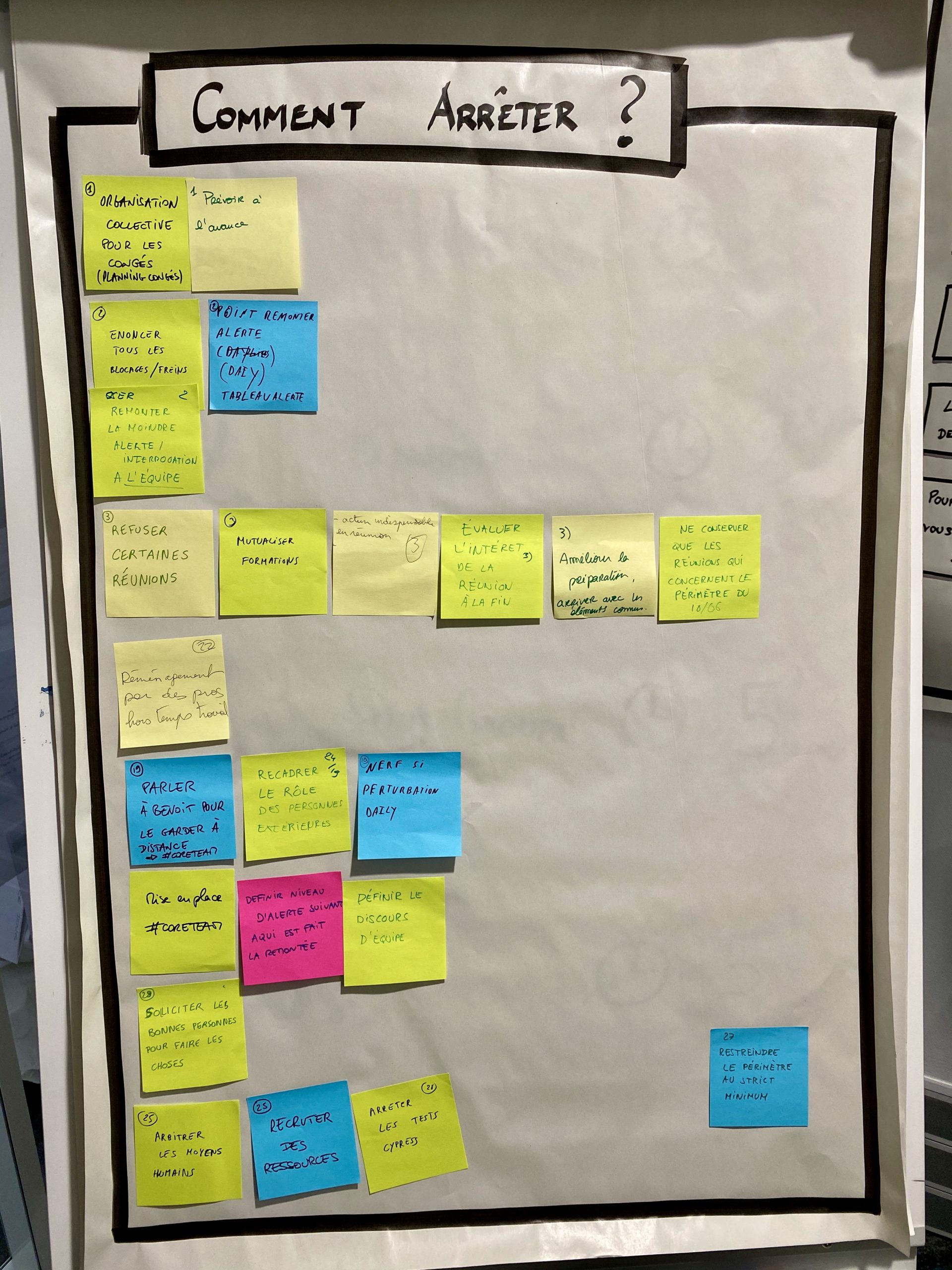
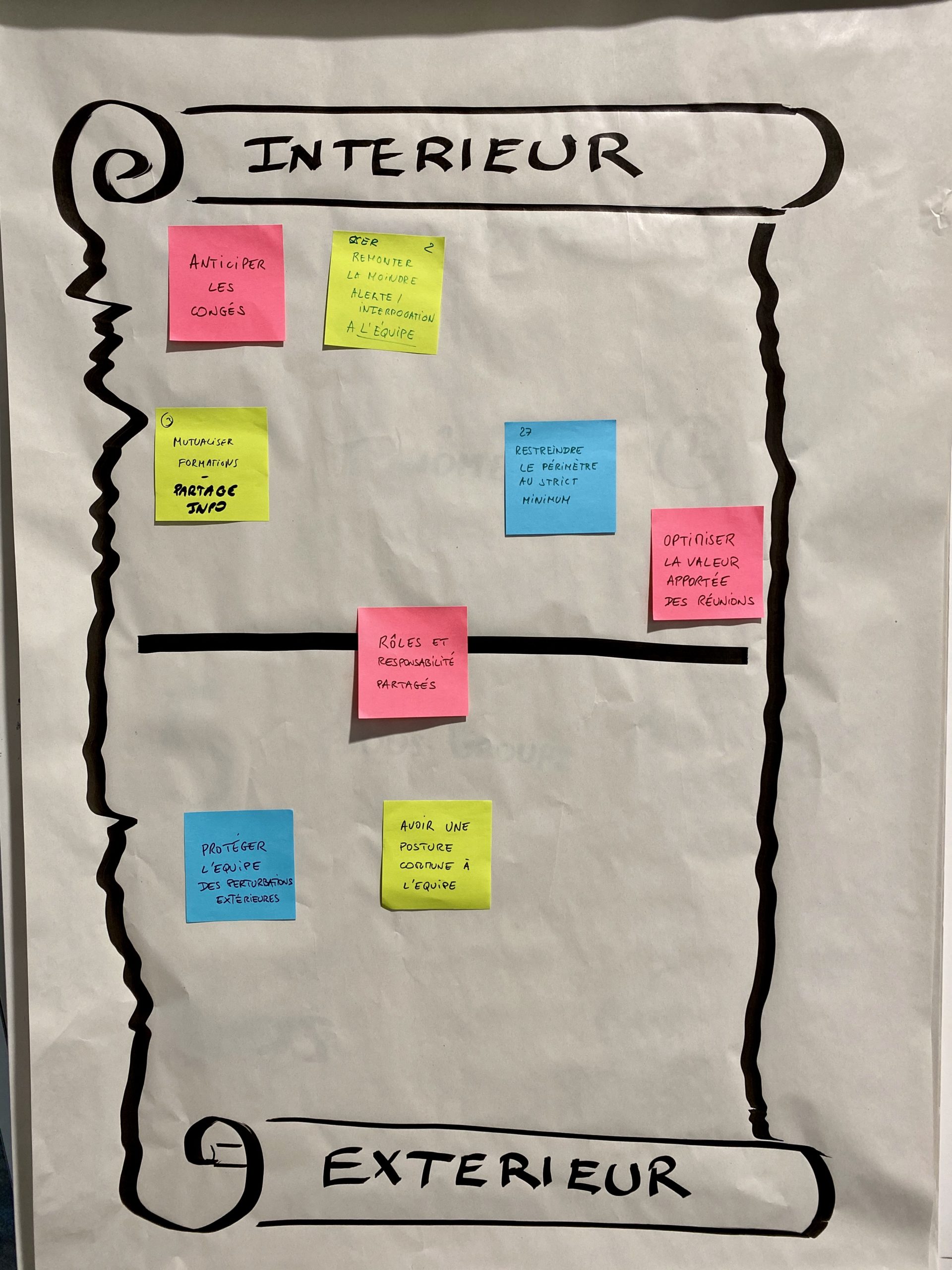






3 réponses
Salut Olivier,
Merci pour ce retour d’expérience détaillé, ça donne des idées!
J’ai une interrogation concernant la toute première question posée sur le TRIZ : « Quel serait le pire résultat imaginable vis-à-vis de vos objectifs et/ou de la stratégie de votre équipe ? ».
Est-ce que les objectifs et/ou la stratégie de cette équipe a été travaillée et était claire aux yeux de tous?
Ou est-ce que c’est quelque chose qu’il faut travailler avec l’équipe avant de proposer ce genre d’atelier selon toi?
D’avance merci!
Salut Julien,
Pour cette première partie, j’ai juste demandé au facilitateur d’expliciter les enjeux et les contraintes de leur projet afin de clarifier la situation actuelle et les objectifs de l’équipe.
Je ne suis pas sûr qu’il y ait un véritable besoin de préparer énormément cette partie, tout dépend de la clarté du contenu pour la personne qui va faire l’exercice et bien évidemment de ses qualités oratoires ! 🙂
Maintenant si cela peut rassurer, tu peux effectivement proposer un temps de préparation mais l’idée reste néanmoins de rester simple et d’aller à l’essentiel.
Dans le passé, j’avais pu le faire légèrement autrement comme décrit dans cet article (dans la partie Vision).
En espérant avoir pu répondre à tes questionnements,
Olivier
Merci bcp pour le partage !
Je ne l’ai pas encore expérimenté, même si j’ai pratiqué l’antiproblème (assez proche : comment détruire / rater etc.).
Ca marche effectivement vraiment bien (et démarche peu connue).
Super idée en tous cas, merci encore !